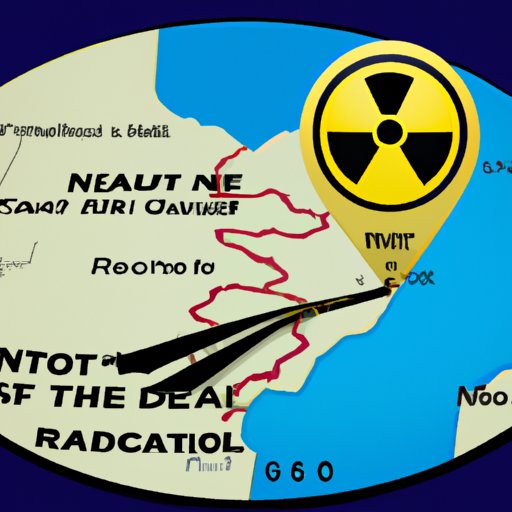Introduction
Nuclear fallout is a term that refers to the radioactive particles that are released into the atmosphere following a nuclear event, such as an explosion or a meltdown. These particles can travel great distances, depending on the type of event and other factors, and can have devastating impacts on both the environment and human health. In this article, we will explore how far nuclear fallout can travel and the effects it has on surrounding areas.

Comparing the Distances of Known Nuclear Fallout Events and their Impact on Surrounding Areas
The most famous and well-known nuclear fallout event is the Chernobyl disaster of 1986. The Chernobyl disaster was one of the worst nuclear accidents in history, resulting in the release of massive amounts of radioactive material into the atmosphere. The fallout from the Chernobyl disaster spread across much of Europe, with the highest concentrations found in Belarus, Ukraine, and Russia. According to the World Health Organization (WHO), nearly 5 million people were exposed to radiation from the Chernobyl disaster and over 6,000 cases of thyroid cancer were reported in children and adolescents who had been exposed to the fallout.
Another major nuclear fallout event was the Fukushima Daiichi nuclear disaster in 2011. This disaster occurred when a tsunami caused by an earthquake damaged several nuclear reactors at the Fukushima Daiichi power plant in Japan. Although the fallout from the Fukushima disaster did not spread as far as the Chernobyl disaster, it still had a significant impact on the surrounding area. The Japanese government estimates that over 160,000 people were evacuated due to the disaster, and there have been reports of increased rates of cancer in the areas affected by the fallout.
Other major nuclear fallout events include the testing of nuclear weapons in the Marshall Islands, the Three Mile Island accident in Pennsylvania, and the Goiânia accident in Brazil. All of these events resulted in the release of large amounts of radioactive material into the environment, but their effects on the surrounding areas were not as severe as those of the Chernobyl and Fukushima disasters.

Examining the Effects of Nuclear Fallout on the Environment and Human Health at Various Distances
Nuclear fallout can have a variety of effects on the environment and human health, depending on the distance from the source of the fallout. At closer distances, the effects can be more severe, while at greater distances the effects may be less noticeable. At all distances, however, it is important to consider the potential health risks associated with exposure to radioactive material.
Environmental Effects
At close distances, nuclear fallout can cause immediate environmental damage, such as the destruction of vegetation, soil contamination, and the contamination of water sources. Over time, the fallout can also lead to changes in the local climate, such as higher temperatures and increased levels of precipitation. At greater distances, the environmental effects may be less noticeable, but they can still have an impact on the local ecology.
Health Effects
At close distances, the health effects of nuclear fallout can be severe, including increased rates of cancer and other diseases. Exposure to high levels of radiation can also cause genetic mutations, birth defects, and other long-term health problems. At greater distances, the health effects may be less pronounced, but they can still occur. For example, studies have shown that people living in areas affected by the Chernobyl disaster have higher rates of certain types of cancer than those living in unaffected areas.
Exploring the Role of Topography and Weather Conditions in Determining How Far Nuclear Fallout Can Spread
The distance that nuclear fallout can travel is largely determined by two factors: topography and weather conditions. The topography of an area can affect how far the fallout can travel by providing obstacles that can block or slow its movement. For example, mountains and hills can act as barriers to the spread of nuclear fallout, while valleys and low-lying areas can allow it to pass through more easily. Weather conditions can also influence the spread of nuclear fallout, as wind and rain can carry the particles over greater distances.

Investigating the Technological Advancements that Allow Scientists to Measure How Far Nuclear Fallout Spreads
In order to determine how far nuclear fallout can travel, scientists use a variety of technologies to measure its spread. Radiological surveillance is a method used to measure the concentrations of radioactive material in the environment. This technique involves taking samples of air, water, and soil and measuring the amount of radiation they contain. Remote sensing is another technique used to measure the spread of nuclear fallout, which involves using satellites to detect radiation from space.
Analyzing the Safety Protocols and Regulations Established to Limit the Spread of Nuclear Fallout
Due to the potentially devastating effects of nuclear fallout, governments around the world have implemented a variety of safety protocols and regulations to limit its spread. On an international level, the Comprehensive Nuclear Test Ban Treaty (CTBT) prohibits all nuclear explosions for any purpose. Additionally, the International Atomic Energy Agency (IAEA) has established safety standards for the operation of nuclear power plants, which must be followed in order to minimize the risk of a nuclear disaster. On a local level, governments may implement additional safety protocols to further reduce the risk of a nuclear accident.
Conclusion
Nuclear fallout can have devastating effects on the environment and human health, and it can travel great distances depending on the type of event and other factors. In order to limit the spread of nuclear fallout, governments around the world have implemented a variety of safety protocols and regulations. By understanding how far nuclear fallout can travel and the effects it can have, we can better prepare for and mitigate the consequences of future nuclear disasters.
(Note: Is this article not meeting your expectations? Do you have knowledge or insights to share? Unlock new opportunities and expand your reach by joining our authors team. Click Registration to join us and share your expertise with our readers.)
